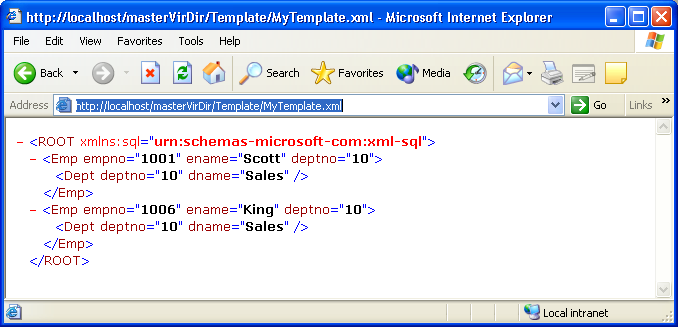With URL
Accessing you can query your MS SQL Server database from the address bar of
your web browser
In the first part we saw how to create and query basic queries and also
how to execute a simple stored procedure. In this part we will see how to
access Database Objects, execute Template Files and XPath Queries.
First let us see how we can
execute Template Files. A Template is
a well-formed XML document containing one or more SQL statements and/or XPath
queries. Templates provide security, as the templates cannot be edited. For
that, create a template file named MyTemplate.xml and type in the code below.
<ROOT
xmlns:sql="urn:schemas-microsoft-com:xml-sql">
<sql:query>
select * from emp Emp,dept Dept where
Emp.deptno=Dept.deptno and Emp.deptno=10
For XML AUTO
</sql:query>
</ROOT>
Now copy the MyTemplate.xml to
\Inetpub\wwwroot\Master\Template directory of your web server and test it by
typing the following in the address bar of your web browser.
http://localhost/masterVirDir/Template/MyTemplate.xml
The element
<query> is defined in sql namespace (i.e , xmlns:sql) thus the namespace
declaration is required. “sql” is only an alias, we can name it anything. The
other elements available are <header>, <param>, <xpath-query>.
The screenshot shows the result.
You can also specify the
templates directly in the URL as
http://localhost/masterVirDir?Template=<ROOT+xmlns:sql="urn:schemas-microsoft-com:xml-sql"><sql:query>select+*+from+emp+Emp,dept+Dept+where+Emp.deptno=Dept.deptno+and+Emp.deptno=10+For+XML+AUTO</sql:query></ROOT>
XML Path Language (XPath) is a
graph navigation language. It is used to select a set of nodes from an XML
document. XPath language is defined by the W3C as a standard navigation
language. XPath Queries are executed
against annotated XML-Data Reduced (XDR) schema, which is an XML view of the
relational data. A detailed explanation of the language is out of the scope of
this article. To query, create a file named MySchema.xml and type in the code
below.
<?xml
version="1.0" ?>
<Schema
xmlns="urn:schemas-microsoft-com:xml-data"
xmlns:dt="urn:schemas-microsoft-com:datatypes"
xmlns:sql="urn:schemas-microsoft-com:xml-sql">
<ElementType name="Emp"
sql:relation="emp" >
<AttributeType name="empno"
/>
<AttributeType name="ename"
/>
<AttributeType name="deptno"
/>
<attribute type="empno" />
<attribute type="ename" />
<attribute type="deptno" >
</attribute>
</ElementType>
<ElementType name="Dept"
sql:relation="dept" sql:key-fields="deptno" >
<AttributeType name="deptno"
/>
<AttributeType name="dname"
/>
<attribute type="deptno" />
<attribute type="dname" />
<element type="Emp" >
<sql:relationship
key-relation="dept"
key="deptno"
foreign-relation="emp"
foreign-key="deptno"
/>
</element>
</ElementType>
</Schema>
Now copy the MySchema.xml to
\Inetpub\wwwroot\Master\Schema directory of your web server and test it by
typing the following in the address bar of your web browser. The screenshot
shows the result.
We can directly access Database Objects as well as shown. This
is primarily used for retrieving binary data. More over the XPath query must
identify a single row and a single column.
We can even write Distributed Queries in the URL as shown.
For more on Distributed Queries refer PCQuest April 2004 issue.
http://localhost/MasterVirDir?sql=select
+*+from+openquery(mysqlDB,’select+*+from+mysql.title’)+as+title+for+xml+auto&root=BookDetails






